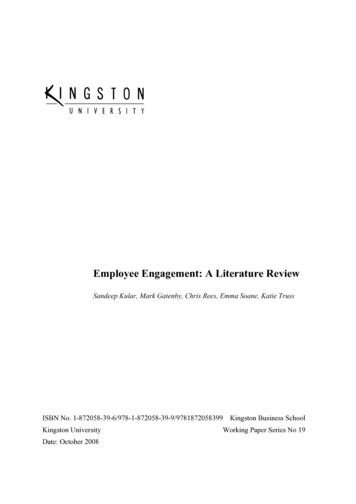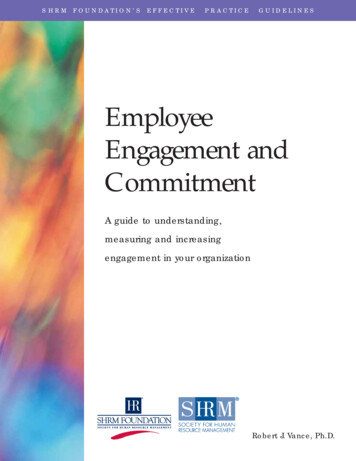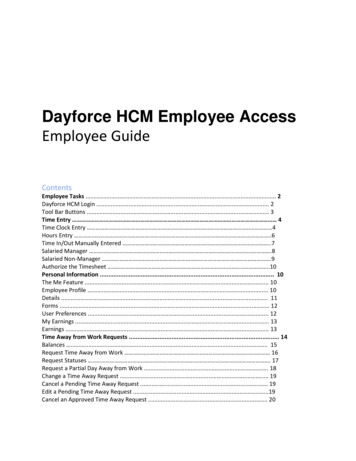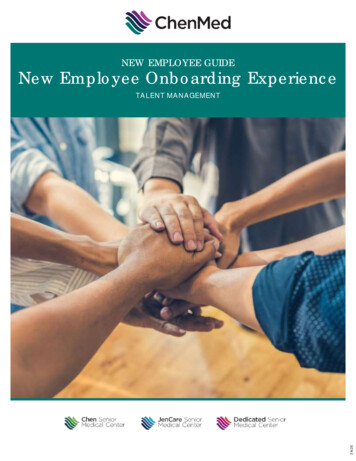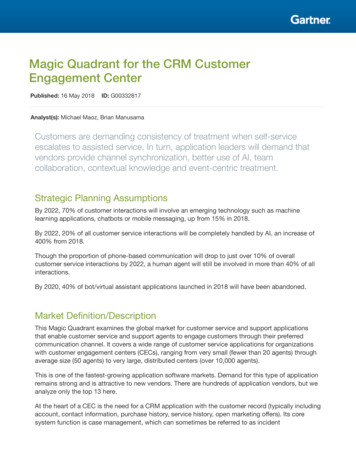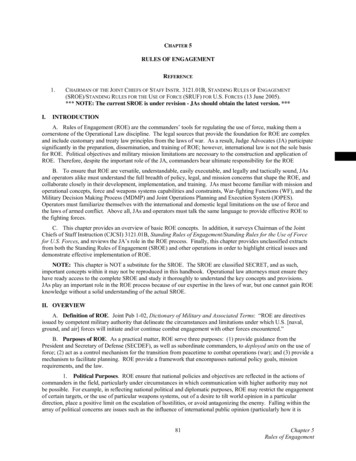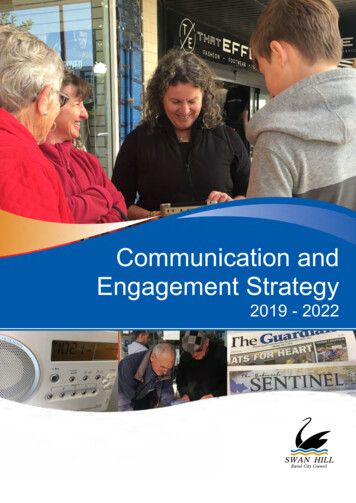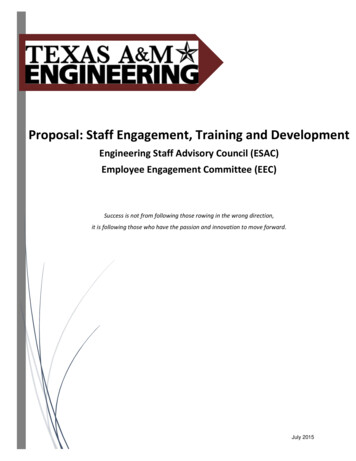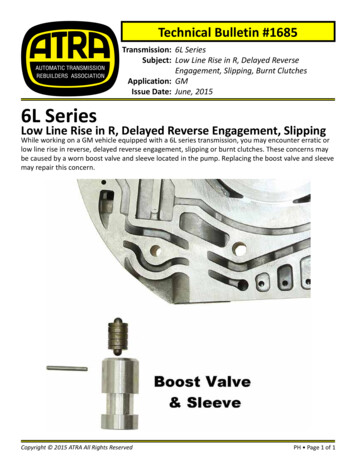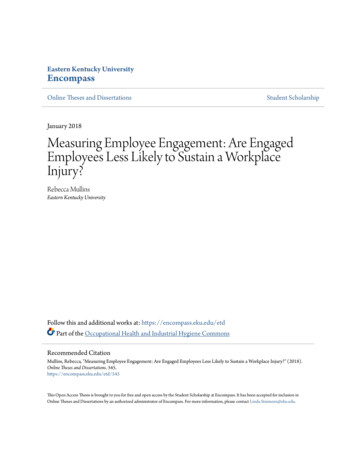
Transcription
Eastern Kentucky UniversityEncompassOnline Theses and DissertationsStudent ScholarshipJanuary 2018Measuring Employee Engagement: Are EngagedEmployees Less Likely to Sustain a WorkplaceInjury?Rebecca MullinsEastern Kentucky UniversityFollow this and additional works at: https://encompass.eku.edu/etdPart of the Occupational Health and Industrial Hygiene CommonsRecommended CitationMullins, Rebecca, "Measuring Employee Engagement: Are Engaged Employees Less Likely to Sustain a Workplace Injury?" (2018).Online Theses and Dissertations. 545.https://encompass.eku.edu/etd/545This Open Access Thesis is brought to you for free and open access by the Student Scholarship at Encompass. It has been accepted for inclusion inOnline Theses and Dissertations by an authorized administrator of Encompass. For more information, please contact Linda.Sizemore@eku.edu.
STATEMENT OF PERMISSION TO USEIn presenting this thesis in partial fulfillment of the requirements for a Master’s degree atEastern Kentucky University, I agree that the Library shall make it available to borrowersunder rules of the Library. Brief quotations from this thesis are allowable without specialpermission, provided that accurate acknowledgment of the source is made. Permission forextensive quotation from or reproduction of this thesis may be granted by my mojorprofessor, or in his/her absence, by the Head of Interlibrary Services when, in the opinionof either, the proposed use of the material is for scholarly purposes. Any copying or useof the material in this thesis for financial gain shall not be allowed without my writtenpermission.SignatureDateflce&!e , Lffi uLd' ls /JJ l:k1't
MEASURING EMPLOYEE ENGAGEMENT: ARE ENGAGED EMPLOYEES LESS LIKELY TOSUSTAIN A WORKPLACE INJURY?BYREBECCA MULLINSSubmitted to the Faculty of the Graduate School ofEastern Kentucky Universityin partial fulfillment of the requirements for the degree ofMASTER OF SCIENCE2018
Copyright by REBECCA MULLINS 2018All Rights Reserved.ii
ACKNOWLEDGEMENTSAs I complete this thesis I look back on all of those people who were selfless enough toserve as a mentor to me along my journey. I would like to thank my thesis chair, Dr.Scotty Dunlap for all of his guidance and support he has given me through this process.I would also like to thank my thesis committee members Dr. Earl Blair and Dr. BarrySpurlock for offering their continual knowledge and encouragement. I would like toexpress my gratitude towards Dustin Wilcher who not only served as my manager, butmy mentor and friend during my internship in which this study took place.iii
ABSTRACTThis thesis focuses on employee engagement in a manufacturing facility and strives todetermine whether less-engaged employees are more likely to sustain an injury whileon the job. Specifically, this study analyzes employee engagement with otheremployees, employee engagement with management, employee engagement withpolicies and procedures as well as employee’s self-initiative. A Likert-scale survey wasadministered and was both voluntarily and anonymously completed by 171 hourlyemployees. The data was then analyzed and it was concluded that certain engagementcriteria, do in fact, relate to an employee’s on-the-job injury status.iv
TABLE OF CONTENTSCHAPTERPAGEI. INTRODUCTION . 1STATEMENT OF THE PROBLEM . 2PURPOSE OF RESEARCH . 2METHODOLOGY AND DATA COLLECTION . 3ASSUMPTIONS . 5LIMITATIONS . 5IMPLICATIONS OF RESEARCH . 5II. LITERATURE REVIEW . 8III. RESEARCH . 13IV. RESULTS . 16Injured Employees . 16Non-Injured Employees . 18Employee Engagement with Other Employees . 19Employee Engagement with Management . 20Employee Engagement with Policies and Procedures . 21Employee Self-Initiative . 22V. DISCUSSION . 24REFERENCES . 28APPENDIXES . 29A. EMPLOYEE ENGAGEMENT SURVEY . 30v
LIST OF TABLESTABLEPAGETable 1. Respondent’s Age. 13Table 2. Respondent’s Gender . 14Table 3. Respondent’s Education . 14Table 4. Respondent’s Length of Employment . 14Table 5. Respondent’s Pay Grade . 15Table 6. Respondent’s Injury Status . 15vi
CHAPTER 1INTRODUCTIONIn relation to safety, a workforce is made up of three very different types ofemployees: the non-compliant, the compliant and the committed (Sims, 2014).Non-Compliant: This employee will bypass any and all safety policies and procedures inorder to maintain high production or personal comfort. These employees, for example,may not fully complete lock-out/tag-out on a machine when performing service in orderto save a few seconds or may refuse to wear their personal protection equipmentproperly just because it is slightly uncomfortable.Compliant: This employee will follow safety policies and procedures and perform dutiesas expected. These employees will wear personal protection equipment, will review aJob Risk Analysis before preforming tasks and will adhere to direction from a supervisor.Committed: A committed employee will not only comply with policies and proceduresput in place, but always has the success of the organization in mind. These employeesdo the right thing, even when no one is looking. For example, a machine operator maynotice that another employee has left the break room without wearing safety glassesand will provide a quick reminder to retrieve them before proceeding to the productionfloor. Committed employees are those who speak up in meetings, express new ideas,and always have the success of the company in mind.As an employer, it is extremely vital to ensure that the workforce is made up ofcommitted, well-engaged employees. Employees who are committed to the values ofthe organization and who take pride in their work contribute to the ultimate success of1
the organization. Identifying engaged employees goes far beyond simply seeing whichemployees show up to their shifts on time. Engaged employees are invested in reachingnot only personal goals, but work on behalf of goals and values established by theorganization. When working to maintain an organization’s safety culture, improve anexisting safety culture, or even create a safety culture in a workforce that seems to lackone, promoting employee engagement is a critical component to consider.STATEMENT OF THE PROBLEMThis research focused on identifying a site’s employee engagement and determiningwhether or not there is a relationship between employee engagement and injuriessustained. Data collected will determine employee engagement within four differentcriteria: Employee engagement with other employees Employee engagement with management Employee engagement with policies and procedures Employee self-initiativeThis research quantified how well employees are engaged at the facility and whether ornot engaged employees are less likely to experience a workplace injury and what, if any,factors contribute to those injuries.PURPOSE OF RESEARCHThe purpose of this research is to identify how engaged a facility’s employeesare in relation to workplace safety. This research identified their level of engagementwith other employees, engagement with management, engagement with policies and2
procedures and identified employee initiative. This research sought to identifyrelationships between certain demographics and engagement criteria. This research alsosought to show relationships between whether or not an employee has sustained aninjury at work and certain engagement criteria. By quantifying engagement levels at thissite, management at this site can take the findings and utilize them to make changes tosafety programs in order to enhance employee engagement and improve the safetyculture if necessary.METHODOLOGY AND DATA COLLECTIONThe research methodology used for this study included administering a surveyat a manufacturing facility. During one of the weekly “Take a Minute” meetings withineach department, supervisors distributed and collected the surveys. Participants bothvoluntarily and anonymously completed the survey. Employees on both first shift andsecond shift were surveyed. The survey collected data about the followingdemographics: age, gender, education, length of employment at the facility, pay grade,and injury status. The survey also included twenty Likert-scale questions with answerchoices including: never, seldom, sometimes, mostly, and always. Each question fell intoa category of engagement: Employee Engagement with Other Employees, EmployeeEngagement with Management, Employee Engagement with Policies and Procedures,and Employee Self Initiative. The Likert-scale survey questions, separated byengagement category, were as follows:3
Employee Engagement with Other Employees: Would you confront an employee about an unsafe act or behavior? Do you participate in discussion during a safety meeting/training? Do you participate in pre-shift stretching? Do you communicate with other employees off work hours?Employee Engagement with Management: Would you report an unsafe act or behavior? Would you want to meet with management to solve safety issues? Do you suggest ideas to improve safety to management?Employee Engagement with Policies and Procedures: How often do you get frustrated when another employee doesn’t follow safetypolicies/procedures? How often do you follow safety policies and procedures? I follow safety policies/procedures; I never take “shortcuts”. Do you support new policies and procedures? Do you fully complete LOTO2 when performing it? Do you feel safety policies/procedures get in the way of performing your job?Employee Self Initiative: Are you likely to be involved in the solution to a safety concern? Would you fix an unsafe situation yourself if you could? Do you review the JRA for your job prior to your shift? Do you stretch during your shift?4
Do you like being rewarded/acknowledged for safe behavior or a safetyimprovement? Do you think of safety while at home with your family? I wear my PPE in good condition.Surveys were administered to both first and second shift hourly employees only. Salaryemployees were not surveyed. 171 anonymous surveys were collected.ASSUMPTIONSThe only assumption that can be made from this research is that all respondentscompleted their survey truthfully. Anonymity was integrated into the research design togenerate truthful responses. This survey was completed voluntarily and there were noincentives for completing the survey.LIMITATIONSAlthough 171 surveys were completed and collected, there are approximately220 hourly employees employed at the site surveyed. The remaining 49 employees notsurveyed may have been absent from work for a number of reasons including, but notlimited to sickness, FMLA, temporary disability, or workplace injury.IMPLICATIONS OF RESEARCHThe data collected from this research and the correlations made betweendemographics and employee engagement with other employees, employeeengagement with management, employee engagement with policies and procedures,and employee self-initiative can help the site surveyed, as well as other organizations5
identify areas for improvement in relation to enhancing employee engagementinitiatives as well as improving their safety culture.By analyzing engagement criteria and correlating it to injuries sustained whileworking in the facility, this research may identify areas in which training needs to beincreased, policies and procedures need to be altered, or corrective measures need tobe enforced. This research will be able to identify whether or not engaged employeesare less likely to sustain an injury while at work and if less-engaged employees are morelikely to sustain an injury and what factors contribute to the injury status of both injuredand non-injured employees.The questions measuring employee engagement with other employees aredesigned to identify whether or not employees feel a sense of community and belongingat work with their colleagues rather than a feeling of isolation. The data collected willidentify whether or not employees care about the well-being of their colleagues andkeep their safety and well-being in mind.The goal of the questions measuring employee engagement with managementis to identify whether or not employees felt as if management had the employee’s bestinterest in mind when in relation to workplace safety. These questions detectedwhether or not employees felt as if they had a voice at work and that their opinions arevalued by those salaried employees.The questions regarding engagement with policies and procedures identifyboth strengths and weaknesses within the safety program and identify areas forimprovement. Employees anonymously and honesty admitted to compliance or lack6
thereof when it came to certain policies and procedures. The data collected from thesequestions could identify errors within certain areas of the safety program and possiblyidentify the need for more corrective actions.Measuring an employee’s self-initiative truly identifies which employees arecommitted to the company. These questions identify whether or not company valuesare instilled in the employees, and cause them to bring their best self to work each day,with the ultimate goals of the company in mind.7
CHAPTER 2LITERATURE REVIEWLudwig and Frazier, (2012) described how employee engagement is not a welldefined construct, as many define it very differently. They explain that according to theGallup Employee Engagement Survey Analysis Tool (ESAT; Corporate Leadership Council,2009) engagement can be broken into rational and emotional engagement. Rationalengagement has been defined as “the extent to which employees believe thatmanagers, teams, or organizations have their self interest in mind”, while emotionalengagement is defined as “the extent to which employees value, enjoy, and believe intheir jobs, managers, teams, or organizations” (Ludwig and Frazier, 2012, p. 76).Woods and Sofat (2013) explained how the concept of engagement is typicallyattributed to Kahn (1990), whose ethnographic research led to the definition ofengagement as “the harnessing of organization members’ selves to their work roles”.Kahn proposed that engaged individuals were physically involved, cognitively vigilant,and emotionally connected with their work (Woods and Sofat, 2013, p. 2203). Woodsand Sofat created a study in which they examined the associations of personality traitsof the Big Five model with work engagement. They found that the personality facetsassertiveness and industriousness were the strongest predictors of work engagement,and that both exhibited direct and indirect effects, mediated by psychologicalmeaningfulness.It has been described how management behavior moderates the relationshipbetween engagement and organizational outcomes and therefore can influence8
employee behavior (Ludwig and Frazier, 2012, p 76). Blessing White, Inc. (2008) identifythat managers must be engaged for their subordinates to be engaged. “Survey datasuggested that management must be customer focused, communicate effectively, andhave the employees’ well-being as a high priority to produce engaged employeesbecause they have built trust” (Ludwig and Frazier, 2012, p 76).Development Dimensions International (DDI, 2005) presented that a managermust exhibit five behaviors in order to create and maintain a highly engaged workforce.These behaviors include aligning efforts with strategy, empowering employees,promoting and encouraging teamwork and collaboration, helping people grow anddevelop, and providing support and recognition where appropriate. (Sridevi andMarkos, 2010, p 91).Much research has been conducted in order to determine the driving factorsthat will increase employee engagement. Sandhya Sridevi, and Solomon Markos,authors of “Employee Engagement: The Key to Improving Performance”, explain thatemployees want to find meaning in their work. According the Penna research report(2007) meaning at work has the potential to be a valuable way of bringing employersand employees together to the benefit of both where employees experience a sense ofcommunity, the space to be themselves, and the opportunity to make a contribution(Sridevi and Markos, 2010, p 91). Penna researchers have also come up with a model ofengagement called “Hierarchy of Engagement”, which compliments Maslow’s Hierarchyof Needs. This model tiers basic employment components that will keep employeesthriving at work. The bottom tier is composed of pay and benefits. After this need is9
met, an employee will look for development opportunities and the possibility forpromotion, which makes up the middle tier. According to the Blessing White (2006)study, almost two thirds of surveyed employees wanted more opportunities to grow inorder to remain satisfied with their jobs. The bottom two tiers of the “Hierarchy ofEngagement” are primarily composed of monetary principles and the prospect to obtainauthority, however, the top tier involves the employee looking to an alignment of valuemeaning, which is displayed by a true sense of connection, a common purpose and ashared sense of meaning at work (Sridevi and Markos, 2010, p 91).When discussing improving participation in safety, it has been noted that thefirst step in increasing employee involvement lies at the forefront of the hiring process.“Organizations with elite employees normally offer competitive salaries and often usean array of selection tools, such as personality tests, biodata instruments, assessmentcenter exercises, vocation tests, structured interviews, and cognitive ability tests”(Williams, 2008, p 40). Active employee engagement is crucial for optimizing a safetyculture. Employees must provide each other with corrective feedback when riskybehavior is identifi
Eastern Kentucky University, I agree that the Library shall make it available to borrowers under rules of the Library. Brief quotations from this thesis are allowable without special . In relation to safety, a workforce is made up of three very different types of employees: the non
